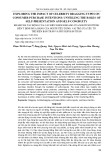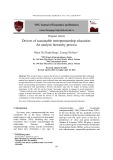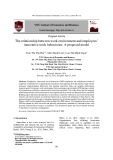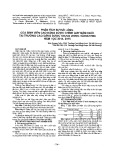
TẠP CHÍ KHOA HỌC - ĐẠI HỌC ĐỒNG NAI, SỐ 33 - 2024 ISSN 2354-1482
73
FACTORS INFLUENCING GEN Z’S DECISIONS TO SHOP
FROM LIVESTREAMS ON E-COMMERCE
AND SOCIAL MEDIA PLATFORMS
Nguyễn Thị Quỳnh Như
Trần Minh Thu
Trường Đại học Ngoại thương
*Corresponding author: Nguyễn Thị Quỳnh Như – Email: nhunguyenquynh75@gmail.com
(Received: 16/6/2024, Revised: 20/10/2024, Accepted for publication: 11/12/2024)
ABSTRACT
The rapid evolution of e-commerce has been significantly shaped by the
integration of livestreaming technologies, which combines entertainment and direct
consumer interaction to renew shopping experiences. This study explored the factors
affecting Generation Z's decision to shop via livestreams on various e-commerce and
social media platforms. With the rise of digital consumption, livestream shopping has
become increasingly popular, especially among younger consumers who prefer
interactive and immediate shopping experiences. This research, conducted within
Vietnam—a rapidly growing e-commerce market—uses a combination of qualitative
and quantitative approaches to examine the consumer behavior of Gen Z. The study
developed a conceptual framework to examine how factors in livestream experience,
live streamer and products influence the shopping decisions of this demographic.
The study sampled Gen Z consumers from Hanoi and Ho Chi Minh City, applying
Structural Equation Modeling to test the proposed hypotheses. Findings highlight
that all the factors in developed model significantly impact the shopping decision of
Gen Z consumers. These elements enhanced engagement and led to personal needs
evaluation which directly correlated with shopping intentions. The study provided a
comprehensive insight into the dynamics of livestream shopping and offers
recommendations for government, businesses, brands and sellers to optimize
approaches to the digitally native Gen Z consumers.
Keywords: Consumer behavior, decision to shop, Generation Z, E-commerce,
Livestreaming
1. Introduction
Existing research on e-commerce
highlights the rapid rise of
livestreaming as an interactive platform
that enhances customer engagement and
influences shopping behavior. Huang
and Benyoucef (2013) note the
economic value of innovative e-
commerce applications, while Hilvert-
Bruce et al. (2018) emphasize
lifestreaming's role in facilitating social
and commercial interactions. Studies by
Zheng et al. (2022) and Giertz et al.
(2021) demonstrate its effectiveness in
boosting brand image and driving sales,
especially during the COVID-19
pandemic (Chen et al., 2022). In
Vietnam, platforms like Facebook help
businesses engage customers by
overcoming barriers to online shopping,
thus increasing trust and purchase
intentions (Tran, 2021). However, most
studies focus on general consumer
bases, often overlooking Generation Z,
whose behaviors reshape e-commerce
strategies. According to Decision Lab
(2022), Gen Z engages with social
commerce through accidental exposure

TẠP CHÍ KHOA HỌC - ĐẠI HỌC ĐỒNG NAI, SỐ 33 - 2024 ISSN 2354-1482
74
to social media, making them a key
target for livestream campaigns.
Despite the growing relevance of
platforms like TikTok and Instagram in
enhancing user experiences, there is a
research gap regarding Gen Z's
decision-making processes in
livestream shopping. This study, titled
“Factors influencing Gen Z’s
decisions to shop from livestreams on
E-commerce and social media
platforms”, aims to analyze the key
drivers of Gen Z’s purchasing decisions
and provide insights for businesses
targeting this influential demographic.
2. Proposed research model
In developing a research model on
factors influencing Generation Z's
shopping decisions via livestreams, the
author employs a secondary model
approach that integrates insights from
previous studies and foundational
theories. The model highlights
interaction as a key feature of
livestream e-commerce, enhancing
social connections and aligning with the
Uses and Gratification Theory. The
attractiveness of the livestream,
including music and visuals, is crucial
for maintaining viewer attention by
providing escapism and entertainment
(Zheng et al., 2022). Additionally, the
streamer’s public image, credibility, and
expertise are essential for retaining
interest, supported by the Source
Credibility Theory. Informativeness and
promotional activities also play
significant roles in engaging consumers
and driving purchase decisions, as noted
by Bawack et al. (2023). Furthermore,
the model incorporates the Theory of
Planned Behavior and Technology
Acceptance Model, suggesting that
personal evaluations of product benefits
and ease of use influence purchasing
behavior. This highlights the complex
interplay of social interaction, media
utility, and consumer engagement in
shaping Gen Z’s livestream shopping
behavior.
Figure 1: Proposed research model by the authors (2024)
Interaction in Livestream
Interaction in livestreaming refers
to the communication between
consumers and livestreamers, as well as
interactions among consumers on the
platform. This includes activities such
as liking, commenting, sending pop-
ups, and giving virtual gifts (Yu et al.,

TẠP CHÍ KHOA HỌC - ĐẠI HỌC ĐỒNG NAI, SỐ 33 - 2024 ISSN 2354-1482
75
2018). The ability to ask questions and
receive immediate responses fosters
trust and interest, leading to higher
conversion rates (Jiang et al., 2024) and
enhancing consumer engagement
through enjoyable interactions (Foster
et al., 2021; Kim et al., 2021). High
interaction levels can captivate viewers,
drawing their attention and influencing
their decision to engage further which
can affect audience value judgments
and encourage purchases (Huang and
Hsu Liu, 2014). Therefore, the
following hypothesis is proposed:
H1. Interaction in livestream
positively impacts customer
engagement.
Attractiveness of livestream
The attractiveness of a livestream is
often determined by the visual and
thematic quality. Elements such as
visuals, music, and overall
entertainment value are critical in
capturing and retaining viewer
attention. Consumers intuitively have a
sense of happiness when they
experience pleasure, which motivates
them to continue watching (Chen and
Lin, 2018). For new viewers, initial
impressions—images, colors, and
sounds—are crucial for retention.
Therefore, the livestream must maintain
consistent appeal to keep consumers
engaged with the product. De Oliveira
& Huertas (2015) argue that
entertainment strengthens the
connection between users and products,
while Salihu et al. (2015) note that
entertainment enhances emotions,
leading to greater satisfaction and
engagement. Well-produced, visually
appealing livestreams attract larger
audiences and sustain viewer interest
(Hou et al., 2022). As a result, the
underlying hypothesis was formulated:
H2. Attractiveness of livestream
positively impacts customer
engagement.
Public image of live streamer
One of the key differences between
livestreaming e-commerce and
traditional e-commerce is the role of the
livestreamer. In traditional settings,
consumers independently search for
product information and make
purchasing decisions. In contrast,
livestreaming features streamers who
actively communicate product details
and persuade viewers to buy. Streamers
use their unique attributes—such as
appearance, eloquence, and market
insight—to convert followers into
customers. Their charisma can reduce
buyer hesitations about unfamiliar
products, enhancing viewer interest and
engagement (Cai, P.J., 2020).
Additionally, well-known streamers
build consumer trust through their
public persona and perceived
authenticity, which fosters greater
viewer interaction and commitment
(Jiao et al., 2023). Therefore, the author
hypothesized:
H3. Public image of live streamer
positively impacts customer
engagement.
Credibility and expertise of live
streamer
Expertise of streamers—defined by
their specific skills and knowledge—
correlate positively with the trust they
receive from viewers (Crisci &
Kassinove, 1973). Agnihotri et al.
(2009) emphasize that sellers with a
deep understanding of their products
can better anticipate customer reactions
and tailor their approaches (Jones et al.,

TẠP CHÍ KHOA HỌC - ĐẠI HỌC ĐỒNG NAI, SỐ 33 - 2024 ISSN 2354-1482
76
2013). Hovland & Weiss (1951) note
that expertise enhances a promoter's
credibility, while Senecal & Nantel
(2004) found that knowledgeable
livestream hosts significantly influence
consumer attitudes and behaviors.
Streamers perceived as experts not only
build viewer trust but also foster greater
participation, leading to deeper
engagement in the livestream (Kim and
Kim, 2022; Liao et al., 2022).
Consequently, the following hypothesis
is proposed:
H4. Credibility and expertise of
live streamer positively impact
customer engagement.
Informativeness of products
Providing informative content
positively influences potential
consumers' attitudes, captures attention,
and encourages participation (Gao &
Koufaris, 2006). Gogan et al. (2018)
suggest that informativeness enhances
awareness by shaping consumer
perceptions and intentions, helping
viewers assess product relevance to
their needs. Timely and detailed
insights from streamers are essential for
keeping viewers engaged, as they are
more likely to stay when provided with
valuable information about products or
trends. Overall, effective
communication of product information
significantly boosts viewer engagement
and reduces drop-off rates during
livestreams. As a result, the underlying
hypothesis was formulated:
H5. Informativeness of products
positively impacts customer
engagement.
Promotional activities of products
Kotler & Keller (2009) describe
promotion as a key communication
strategy that helps businesses share
relevant information to stimulate
demand and encourage purchases.
Promotions often involve short-term
incentives aimed at exciting consumers.
Effective promotional tactics during
livestreams, such as discounts and
exclusive offers, can create urgency and
significantly enhance viewer
engagement. The research further
emphasizes that varied promotional
strategies can boost consumer
interaction with product listings and
encourage exploration of the brand's
online presence, which are crucial for
driving viewer interest and facilitating
sales. Therefore, the author proposes
the following hypothesis:
H6. Promotional activities of
products positively impact customer
engagement.
Customer engagement
Customer engagement is a crucial
aspect of social commerce,
characterized by activities like
commenting, liking, and sharing during
livestreams, which indicate viewer
interest (Kim et al., 2017). Engaging
with livestreams helps consumers build
strong connections with brands,
prompting them to evaluate how
products meet their needs (Zheng et al.,
2022). Higher engagement levels
correlate with increased consumer
interest and the likelihood of assessing
personal needs before making purchases
(Katona et al., 2011). As a result, the
following theory has progressed:
H7. Customer engagement
positively impacts personal needs
evaluation.
Personal needs evaluation
Personal needs evaluation is the
process by which viewers determine if
the products showcased in a livestream

TẠP CHÍ KHOA HỌC - ĐẠI HỌC ĐỒNG NAI, SỐ 33 - 2024 ISSN 2354-1482
77
align with their preferences, potentially
leading to impulse buying if they feel
justified in their decisions (Rook &
Fisher, 1995). During a livestream,
viewers assess the relevance of
purchases based on presented
information, often leading to immediate
satisfaction. For example, a viewer
might identify a need for a product and
perceive it as fitting their requirements
due to its highlighted benefits. The
exclusivity of livestream offers
enhances perceived product value,
making items more desirable (Stern,
1962). Ultimately, consumers evaluate
their needs against the showcased
products, with the effectiveness of this
evaluation hinging on the streamer's
ability to present the product
comprehensively (Pei & Mayzlin,
2022). The following hypothesis is
proposed:
H8. Personal needs evaluation
positively impacts purchase decision.
3. Methodology
The author employed a 27-question
quantitative questionnaire using a Likert
scale (Likert, 1932) to investigate Gen
Z's shopping decisions via livestreams
on e-commerce and social media
platforms in major urban centers of
Vietnam, specifically Hanoi and Ho Chi
Minh City. The sample size was set
between 135 and 200 respondents,
following Hair et al. (2009), who
recommend five to ten times the
number of scales used. Data collection
occurred through Google Forms and in-
person surveys, targeting university
students and active social media users,
resulting in 295 responses collected
from March 25 to April 25, 2024, with
278 valid samples retained after
cleaning.
In terms of data analysis, the study
utilized IBM SPSS 25 for descriptive
statistics to summarize demographics,
and Cronbach's Alpha was applied for
reliability testing, with values above 0.6
deemed reliable (Nunnally, 1978; Hair
et al., 2009). Exploratory Factor
Analysis (EFA) and Confirmatory
Factor Analysis (CFA) were conducted
to refine and validate measurement
scales and model structures. EFA
indicated a suitable data structure for
meaningful factor extraction, while
CFA confirmed model fit using
indicators such as CMIN/df and
RMSEA (Hoelzle and Meyer, 2013; Hu
& Bentler, 1999).
4. Findings and discussion
4.1. Demographic analysis
The research examined the
behaviors and demographics of 278
survey respondents, predominantly
female (53.2%), highlighting significant
engagement in livestream shopping
among younger adults, especially those
aged 22 to 27 (39.9%). This group
mainly comprises students and early
career professionals, with 39.9%
earning below 5 million VND per
month. Most respondents use social
media and e-commerce platforms for 1
to 3 hours daily, with 60.1% making
purchases via livestream 1 to 3 times a
month, favoring Shopee and TikTok.
Descriptive statistical analysis revealed
low variability in responses, indicating
consistent perceptions among
participants, particularly regarding the
livestreamer's public image, product
informativeness, and personal needs
evaluation. Interaction, credibility, and
content informativeness received
positive ratings, with mean values
above 3, suggesting a favorable


























